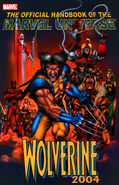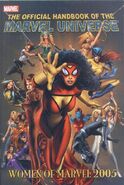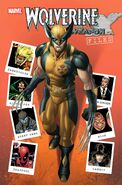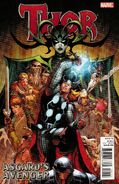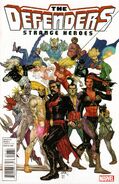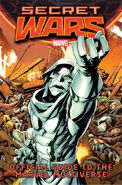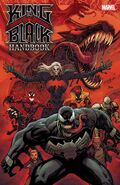Overview[]
The Official Handbook of the Marvel Universe, also known as OHOTMU, is a guide which attempts to detail the Marvel Universe. The original 15 volume series was published in comic book format in 1982.
It is also the inspiration for the Marvel Database Project.
The abbreviation "Ohotmu" was used as the name of a Watcher in What The--?! #16.
See also Category:Handbooks
Origins[]
Jim Shooter, Marvel's then Editor in Chief, initially came up with the idea for the project, envisioning a guide detailing statistics much in the manner of those found upon the backs of baseball cards.[1] Shooter intended it to be an answer to frequent readers' post mail asking for technical questions.[1]
This initial project was to be called The Marvel Super-Specifications Handbook,[1][2] but the word "specifications" was removed because it was too formal, hard to spell and bad for a logo; and the prefix "super" was disliked by Shooter for personal reasons. They took "Marvel Universe", Al Milgrom's intended title for what later became Marvel Fanfare.[1]
Shooter appointed Mark Gruenwald editor of the project, and in Gruenwald's hands the project gained its published name and also grew in scope to cover all aspects of the Marvel Universe, although Gruenwald himself noted it was not comprehensive.[3] Gruenwald, as the project's editor, decided which active characters would be featured and how (Eliot R. Brown and Mike Carlin purportedly were angry because Devil Dinosaur was deliberately excluded). Jokingly, the staff claimed to have made up limericks and songs of the characters they were working on, including Orka-Dorca-Doo, as told in a bulletin published in Amazing Spider-Man #250.[1]
Critics of the handbook have argued that the level of detail within the guide effectively limited the ability of writers to innovate, a charge Gruenwald dismissed, reputedly stating that the information presented was only the most recent data and was subject to change.[4] Peter Sanderson, one of the writers of the original guide, noted that "Mark sought to make the Marvel characters' super-powers as firm a basis in real science as possible. After the first version of the Handbook, Mark decided that some of the explanations had grown too complicated, and asked me to simplify them."[5]
The OHOTMU detailed the more significant characters, items and locations in the Marvel Universe, itemizing them into individual entries. Individual entries consisted, in most cases, of:
- A frontal full-body view of the character. These illustrations were drawn solely for the OHOTMU, often by the artist most closely associated with the character; for example, the original entries for Elektra and Bullseye were illustrated by Frank Miller.
- Prose text describing the character's origin, powers, and other abilities and unique traits, as well as 'statistics' such as place of birth, former aliases, height, weight, hair and eye color and so forth. The original edition opted only to describe the "Origins" of characters (how they acquired their powers), instead focusing heavily on detailed explanations for how those powers functioned. In in its Book of the Dead supplement, however, the handbook provided entire "Histories" for the deceased characters, a trend which was then adopted for the main body of the Deluxe Edition, allowing the entire life and career of the characters to be covered. In a few cases, the Handbook even included previously unrevealed information. In addition, major important pieces of equipment were given technical illustrations with breakdowns of their functions and features.
- Example pictures of the character in action, taken directly from the comics themselves.
In the original OHOTMU, characters were listed at one character per page, although minor characters were sometimes listed at two to a page and major characters would occasionally receive more than one page. In the Deluxe Edition, however, every character received at least one page; the most significant characters such as Captain America or Iron Man could receive up to 3-5 pages for their writeups; less important characters, such as Sunspot or Volcana, typically received one or two pages.
In the Master Edition (1990-1993) this reverted and every character, major or minor, was given the same amount of space - both sides of single loose leaf page. In the latest (2004- ) version this has been changed back again and now characters receive different lengths of entry depending on their history and importance; with all images being taken directly from the comics instead of being drawn specifically for the OHOTMU.
There have been many iterations of the OHOTMU concept since it was first launched in 1982:
- 1982-1984: a 15-issue series; this was the original OHOTMU. Issues 13 and 14 were the Book of the Dead and Inactive, featuring characters and groups who were, at the time, believed dead or inactive, and issue 15 was the 'Book of Weapons, Hardware, and Paraphernalia', featuring technical drawings of Iron Man's armor, Spider-Man's web-shooters and other notable characters' equipment. The back of each issue in the series featured a brief Appendix, giving one-line listings for minor and inactive characters.
Initially intended to be a 12-issue series covering only active characters, it got such as enthusiastic response from the public -also including data corrections and complaints- that Gruenwald and his staff expanded it for two more issues including deceased characters (and probably also for the last issue about items).[1]
- 1985-1988: a 20-issue series, updating the original into a Deluxe Edition (OHOTMUDE for short). The last five issues of this series were, again, the 'Book of the Dead', cataloging characters that were believed dead at the time; the technical drawings from the original series' supplemental 'Book of Weapons' were reproduced and updated in the relevant characters' main entries or, in a few cases, receiving their own entries. The '85-'88 run (Deluxe Edition) has also been collected in trade paperback format, a series of 10 thicker volumes of 128 pages each. Although numerous entries reference an Appendix, the Deluxe Edition Appendix never materialized.
- 1989: the OHOTMU Update '89 was published, an 8-issue series. This series is notable for including numerous non-superhuman supporting characters, where previous runs had all but neglected them.
- 1990-1993: OHOTMU Master Edition was a 36 issue series in which each issue was actually a shrink-wrapped pack of loose-leaf pages each featuring a character; rather than offering prose information, concentrates more on trying to make up accurate statistics for characters. The edition included approximately 815 character pages, 22 team action sheet featuring a team's line-up, and 7 action sheets featuring information on support characters for a hero. Each character page offered a full profile of the character's body: front, side, and back, except for 12 cases where the dimensions of the character made it difficult to adjust to the sheet, and one, Doughboy, who was presented in front, side and dive. All the images were drawn by the same artist: Keith Pollard.
- 2004-2005: Marvel has been releasing individual one-shot OHOTMUs that supplement the Marvel Encyclopedia, which target specific families of characters, beginning with Official Handbook to the Marvel Universe: X-Men 2004. Other entries in this themed, subtitled series include Spider-Man 2004, Avengers 2004, Hulk 2004, Daredevil 2004, Wolverine 2004, Golden Age 2004, Women of Marvel 2005 and Avengers 2005. One Handbook a month is planned through 2005.
- 2006: A new twelve-issued series is planned for release throughout this year, one issue per month, covering characters from across the Marvel Universe. Characters who have already received profiles in the one-shots of the past two years will apparently be excluded, allowing the series to focus entirely on characters in need of major handbook updates, or who have never had an entry at all. A series of one-shot issues will also be released throughout the year in the same style as the 2004-2005 books to focus on major groups of characters. This year will also see the original Handbook series, original 20-issue Deluxe Edition, and the Update '89 edition reprinted in three large Essential volumes.
The OHOTMUDE is the most familiar version of the OHOTMU to fans as it was distributed more widely and was of a more reasonable price than the OHOTMU Master Edition. Its trade paperback version is also the most durable OHOTMU available. Unfortunately, it is currently almost two decades out of date, the last issue having been released in 1988.
In addition to the Marvel Universe, Marvel published a number of handbook-style products for their licensed properties, among them Conan the Barbarian (The Official Handbook to the Conan Universe), G.I. Joe (G.I. Joe Order of Battle) and the Transformers (Transformers Universe).
It is amusing to note that in certain humor-based Marvel publications, such as What The--?!, "Ohotmu" has been used as the name of a parody version of a Watcher, as a play on the Watchers' reputations as far-seeing and possessing of great knowledge and for the phonetic pronunciation of OHOTMU (most often "oh-hot-moo") sounding similar to the name of the best-known Watcher, Uatu ("oo-wa-two").
Main Series[]
One-Shots and Limited Series[]
Mini-Handbooks[]
Marvel have also realeased a series of "Mini-Handbooks" which are smaller in nature and contain fewer profiles.
